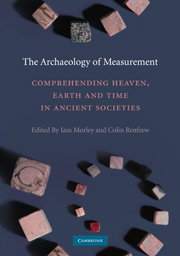Book contents
- Frontmatter
- Contents
- List of figures and tables
- List of contributors
- Acknowledgements
- The Archaeology of Measurement
- Introduction: Measure: Towards the construction of our world
- SECTION I NUMBER: COUNTING, MATHEMATICS AND MEASURE
- SECTION II MATERIALISING THE ECONOMY
- SECTION III DIMENSIONS AND BELIEF
- SECTION IV CALENDAR AND COSMOLOGY
- SECTION V THE SPIRITUALITY OF MEASURE
- Index
SECTION IV - CALENDAR AND COSMOLOGY
Published online by Cambridge University Press: 05 June 2012
- Frontmatter
- Contents
- List of figures and tables
- List of contributors
- Acknowledgements
- The Archaeology of Measurement
- Introduction: Measure: Towards the construction of our world
- SECTION I NUMBER: COUNTING, MATHEMATICS AND MEASURE
- SECTION II MATERIALISING THE ECONOMY
- SECTION III DIMENSIONS AND BELIEF
- SECTION IV CALENDAR AND COSMOLOGY
- SECTION V THE SPIRITUALITY OF MEASURE
- Index
Summary
The theme of the relationships between terrestrial and celestial aspects of the world is elaborated further in Section IV, whose chapters are united by a principal focus on the measurement of time. The opening section of David Brown's contribution focuses on the notions of concrete and abstract number in Mesopotamia, before going on to consider in detail the measurement of time and its relationship with terrestrial and cosmological measures. Brown initially argues that the existence of ‘concrete number’ systems in Mesopotamia (with both quantity and quality [commodity] being represented by a single symbol, repeated the appropriate number of times) does not represent a lacuna in human cognition (an inability to conceptualise abstract number) but is instead a product of administrative practice. When this administrative mechanism changes, the use of abstract number becomes conspicuously part of the arithmetical system. However, he argues, evidence for the cognition of the concept of abstract number exists before; that is, it is a transformation in practice, rather than human cognition, that is represented by this change.
In Mesopotamia the measurement of the passage of time became linked intimately with the measure of distance, via the distance between ‘rest stops’ (covered at walking speed on foot march) and the duration of a day. This formed part of an idealised system of relationships among distance, time and astronomical movements, including idealised durations for days, months and years, which, Brown suggests, accorded with a concept of the ideal creation.
- Type
- Chapter
- Information
- The Archaeology of MeasurementComprehending Heaven, Earth and Time in Ancient Societies, pp. 181 - 182Publisher: Cambridge University PressPrint publication year: 2010



